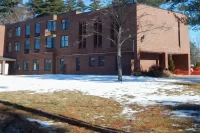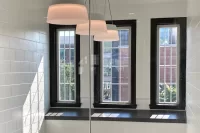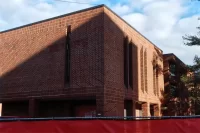
Campus Construction Update: Feb. 6, 2015
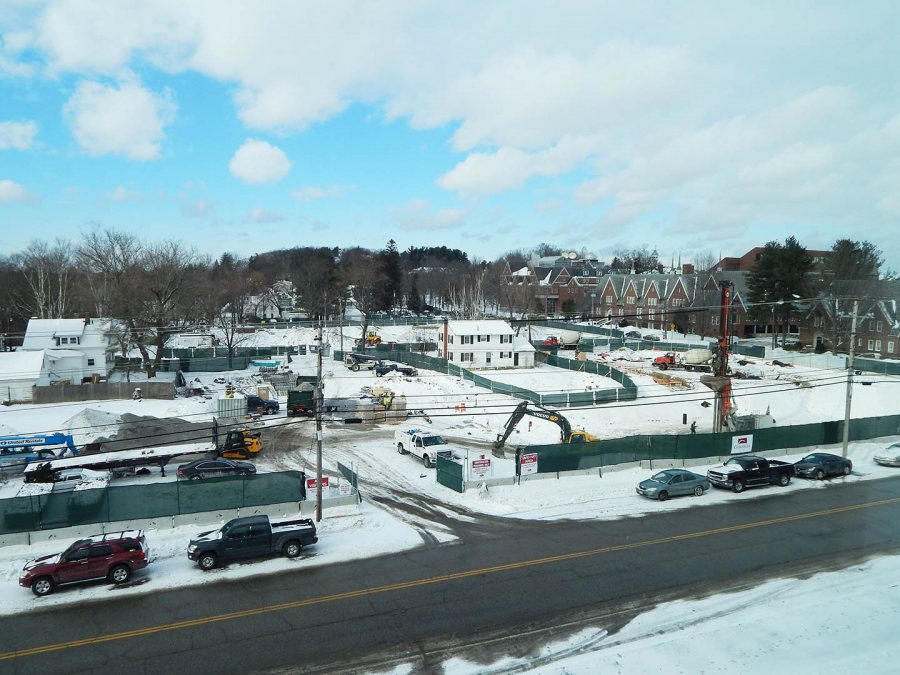
A view of the 65 Campus Ave. construction site from an upper story of Lewiston Middle School on Jan. 9, 2015. At right, the orange boom and the two concrete trucks roughly indicate the placement of the forthcoming student residences. (Doug Hubley/Bates College)
It’s hard to know for sure just what’s happening underground. And if the moles and worms know, they aren’t talking.
In fact, the unpredictability of subsurface soil has been a matter of acute interest to Bates and its partner in the Campus Life Project, Consigli Construction, for the past couple of weeks.
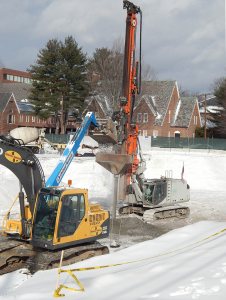
With Muskie Archives in the background, a loader feeds aggregate to the Helical Drilling rig implanting Geopiers on Jan. 9, 2015. The same rig without the aggregate hopper is used to make GeoConcrete Columns. (Doug Hubley/Bates College)
The salient soil is in a section of the 65 Campus Ave. construction site. As we reported previously, underground deposits of slippery marine clay in an area parallel to Central Avenue make the earth too unstable to support a building foundation.
The solution was to sink more than 250 rammed aggregate piers, aka Geopiers. These subterranean grout-and-stone structures, each resembling a stack of doughnuts, help stiffen and stabilize the soil.
But in the case of that dirt near Central Avenue, they don’t stiffen and stabilize enough, we’ve learned. Load tests conducted by subcontractor Helical Drilling on Jan. 19 revealed that more reinforcement is needed.
The solution this time is the GeoConcrete Column, a technology developed by the Virginia firm GeoStructures Inc.
The Geopiers and GeoConcrete Columns share some family resemblances. Both are vertical structures implanted in the ground en masse — the 233 new columns, in fact, will be interspersed among the Geopiers. And to inject and ram down the columns, Helical Drilling will use the same boom and mandrel that it used to plant the piers.
But, as the brand name tells you, the columns are made of solid concrete instead of the Geopiers’ batter of aggregate and grout. And where the Geopiers are designed to stabilize the earth around them, improving its weight-bearing capacity, the columns will instead carry the building’s weight down to solid soil.
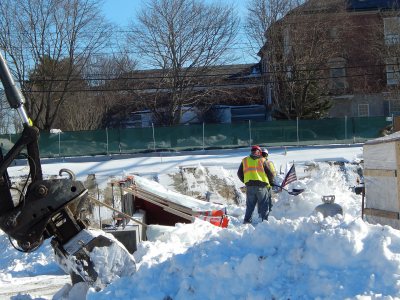
Construction workers clear snow from the foundation-in-progress of the 65 Campus Ave. residence on Jan. 29. (Doug Hubley/Bates College)
Finally, where the mandrel’s ramming action gave the Geopiers their distinctive stack-of-doughnuts shape, the pounding gives each GeoConcrete Column one big bulge at its base. Like an onion while it’s still in the ground.
So despite the similarities, you can’t really compare the Geopiers to the GeoConcrete Columns. It’s very much a doughnuts vs. onions comparison.
Why didn’t the Geopiers work as intended? The many possibilities include marine clay deposits that are more extensive than anticipated. But, says Bates project manager Chris Streifel, “I’d be speculating to give any specific reason. The contractor’s working to figure that out.
“In the meantime, they’ve moved forward with the columns, and that allows them to be very confident that the next results will be what we’re looking for.”
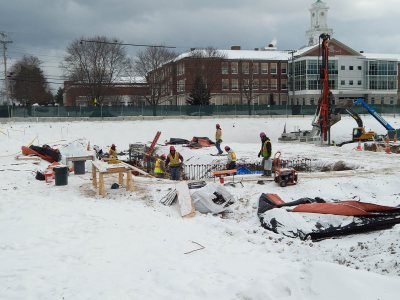
While Helical Drilling machinery, at right rear, sinks Geopiers, other workers tend to concrete footings for the 65 Campus Ave. residence on Jan. 9, 2015. (Doug Hubley/Bates College)
He adds, “It was a setback — I wouldn’t characterize it otherwise. But it’s really been a good experience in the way the project team met the challenge and made the right adjustments to their planning. Everybody has stepped up to do the job and keep things on track.”
The response of Consigli, which is managing the construction for Bates, was “exemplary,” Streifel says.
He doesn’t expect a significant impact on the construction timetable from the added work. “They’ll be working aggressively to finish it up as quickly as possible,” he says, perhaps by Valentine’s Day.
One of two student residences to result from this phase of the Campus Life Project, the 65 Campus Ave. building will have a partial basement where the new columns are going in.
After placing a layer of fabric-shrouded gravel over the column tops, workers will pour concrete footers to support the building structure, along with the basement floor. Streifel anticipates that extra workers will be brought in for that job to gain back lost time.
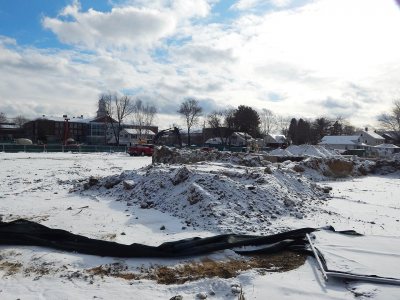
The former site of 53 Campus Ave., which housed the Career Development Center and the Writing Workshop. The area has been graded level since this image was taken on Jan. 9, 2015. (Doug Hubley/Bates College)
But the other part of the L-shaped residence at 65 Campus Ave. has neither a basement nor soil issues, and there foundation work has been proceeding apace . . . in between snowstorms.
Since Jan. 27, Lewiston has experienced four snowfalls over five days, totaling about four feet of winter wonderland. This overdose “is not helping anything,” Streifel says. Either the snowstorms are shutting down the site entirely or crews are losing production time removing snow.
“That’s working in the winter,” he allows. “Getting out of the holes in the ground and getting out of the winter will be a win for us.”
When it comes to pouring concrete, cold can’t be ignored. Concrete gets its strength from a chemical process impaired by low temperatures. The work, Streifel says, becomes “more labor-intensive, and requires more planning and the proper use of heat, blankets and concrete additives to ensure that the curing happens appropriately.”
Despite all that, concrete footings for walls and support columns are in place. Progress is apparent to anyone who, like Campus Construction Update, has a ladder to peer over the construction fence.
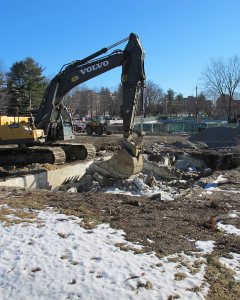
Removing the remnants of a Bardwell Street house foundation on Jan. 20, 2015. (Doug Hubley/Bates College)
Where the focus at the 65 Campus Ave. site is on constructing foundations, the task at 55 Campus is just the opposite: gouging out old foundations of the wooden houses that once stood there. This is done with a jackhammer mounted on the boom of a power shovel that reaches into the cellar hole and breaks up the concrete, making a lot of vibration. The concrete debris is scooped out and trucked away, and the ground is leveled for the next phase.
Here too, despite the construction fence, progress is apparent. When our penthouse suite one block away in the Bates Communications Office compound starts to quake, we know another foundation is coming out.
And there they go again.
Can we talk? Campus Construction Update welcomes your questions and comments about current, past and future construction at Bates. Write to dhubley@bates.edu, putting “Campus Construction” or “Have you ever had onion doughnuts?” in the subject line. Or use the 21st-century commenting system below.
